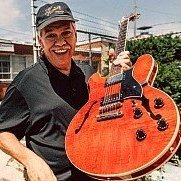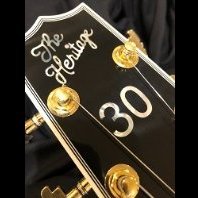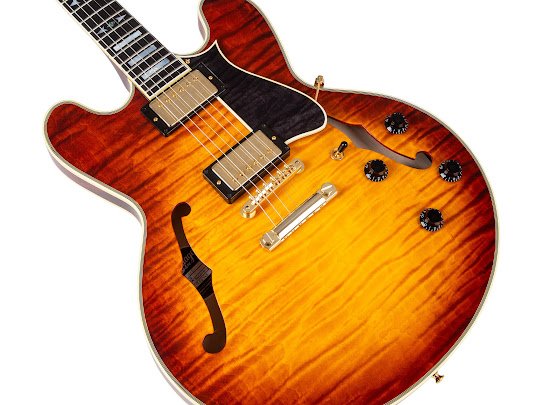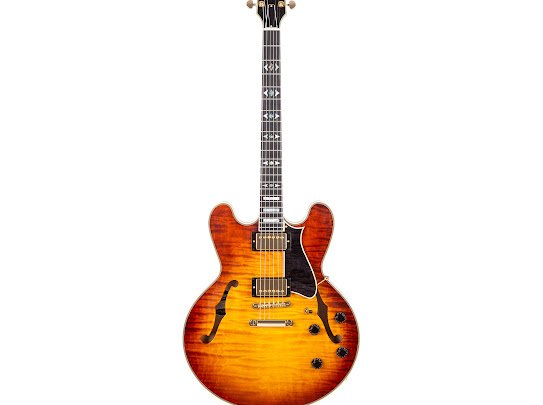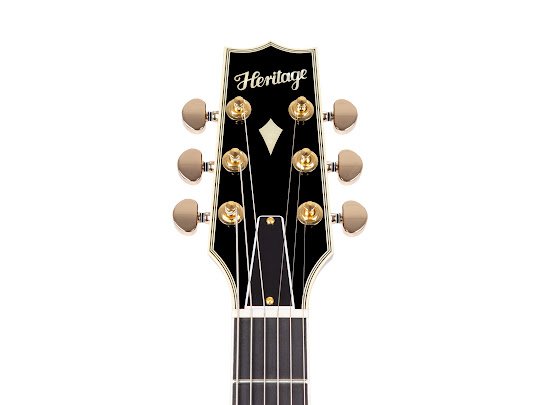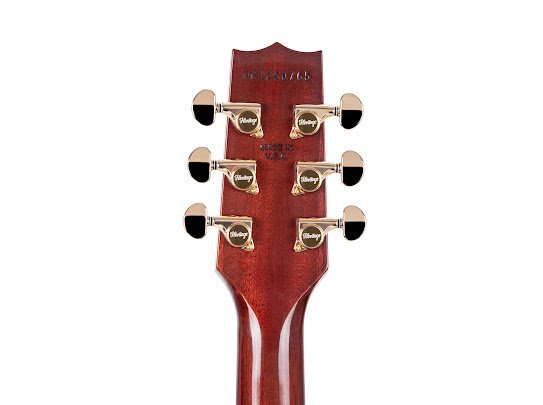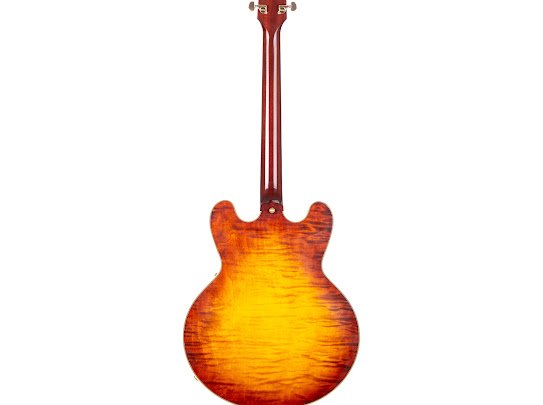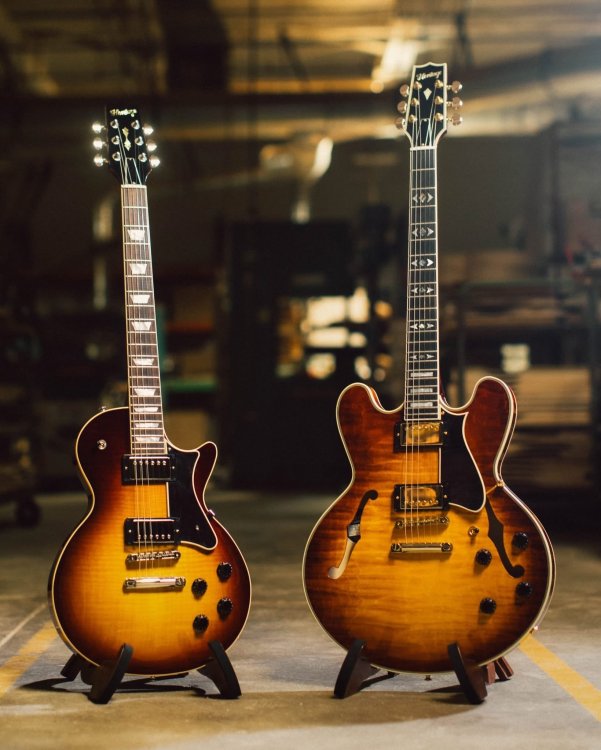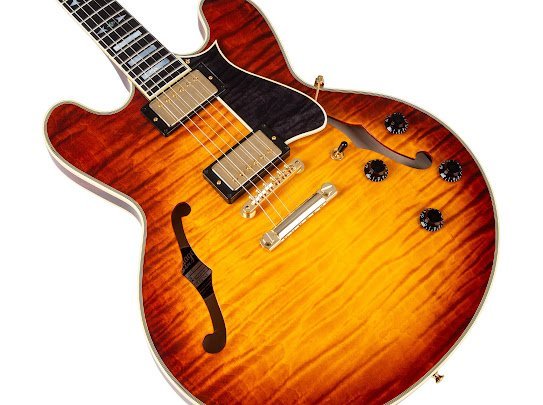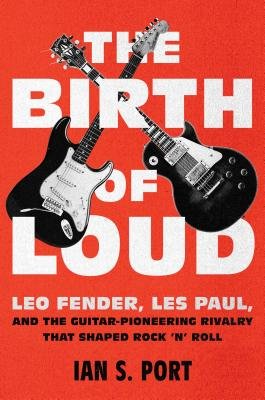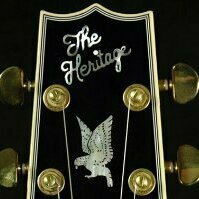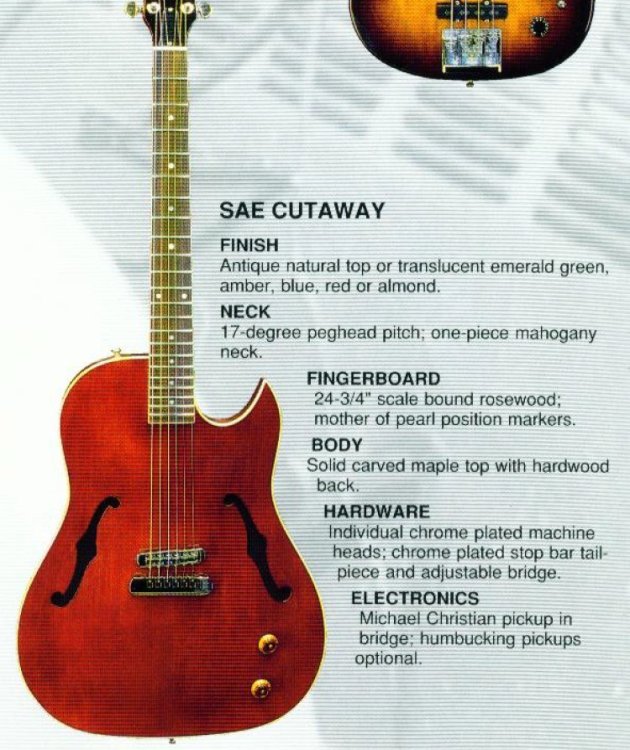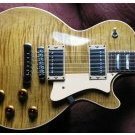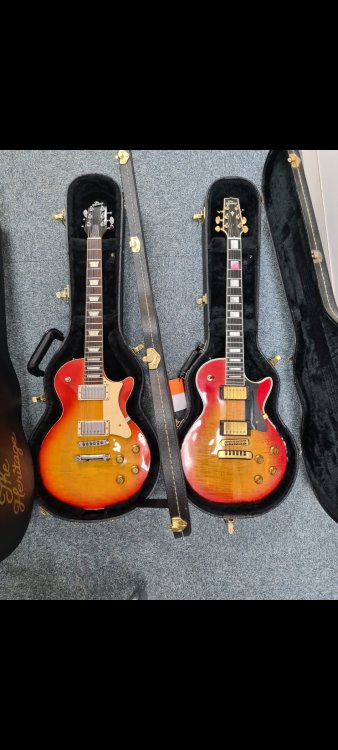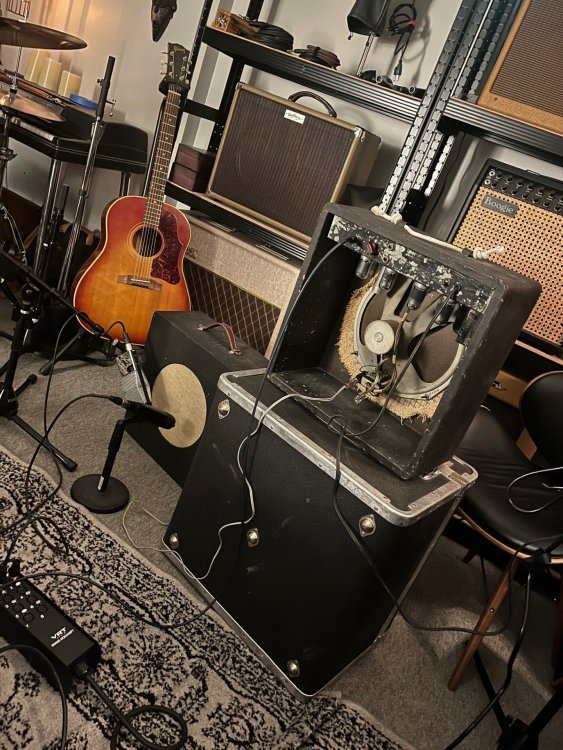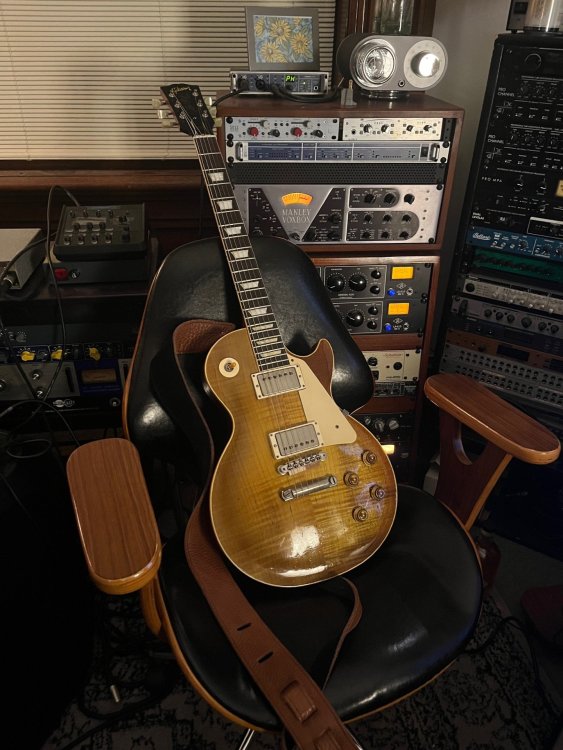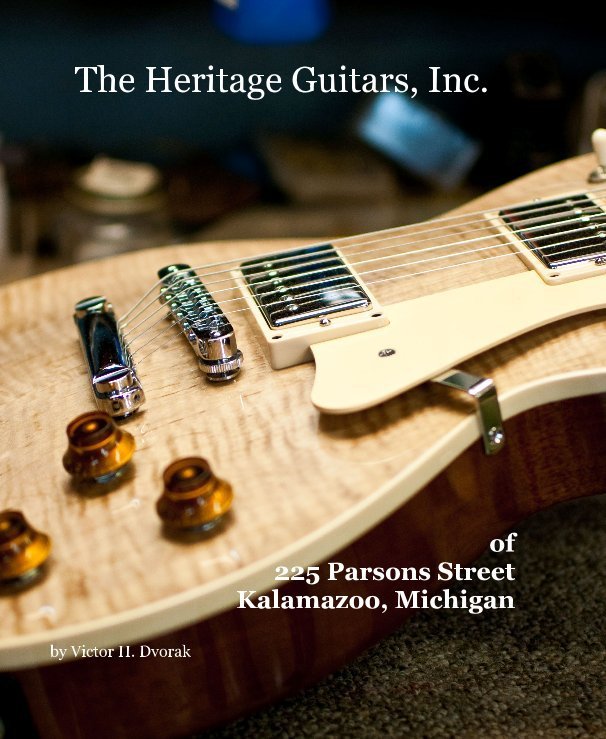Leaderboard
Popular Content
Showing content with the highest reputation since 06/01/25 in all areas
-
I was looking for a dedicated performance photo thread and didn't see one (apologies if I missed it!), but wanted to share a few photos since I've been playing the '94 H150 as my primary live guitar lately. Band has had a wave of local gigs lately and hoping to have debut album out August/Sept: https://makingfriendsasadults.bandcamp.com/track/bad-time5 points
-
4 points
-
Okay, so Brother Bolero shamed me into looking at the Heritage offerings . . . I find this one really looking good to me: https://www.sweetwater.com/store/detail/H150CSFSOTB--heritage-custom-shop-factory-special-standard-h-150-plain-top-electric-guitar-original-tobacco-burst I'm curious about H's choice of Lollar Imperial pups instead of the Seth Lovers H puts in the lower end 150s . . . And this one's in the discussion: https://eddiesguitars.com/product/gibson-catalogs/gibson-custom-shop/gibson-custom-shop-psl-58-les-paul-standard-reissue-vos-sunrise-tea-burst-8-4-83129/ Part of a special run for Eddies Guitars with a focus on lighter weight, great price for a CS guitar, I think. I'm really drawn to the plain top R8 look. Observations and flames requested. Looking forward to being at PSP in about a month!3 points
-
3 points
-
I am assuming that even though the tuner is covering the brand, it looks like an H-530. This guy gets a nice smooth tone on those P-90s.3 points
-
That version of the tailpiece and bridge was made by Schaller of Germany. They still sell the roller bridge, but I don't think the tailpiece is a current item. Thomann is a Schaller dealer. https://schaller.info/en/bridges/ If you want to change the style to a more common bridge and tailpiece, many people here swear by the Faber units. The trick it to make sure that you use the correct spacing.3 points
-
3 points
-
Stock market has been good to me lately, solved the "dilemma" and purchased both! Time for a cold 🍺2 points
-
And, what with this encyclopedia of The Heritage and the treasure trove of info in threads over time relating to our blessed Heritage(s), we have our place If one wants to do any Heritage Guitar “deep diving”. Sometimes it’s not the cume, (defined as cumulative # of people coming through the door), but “Time Spent Listening”. As in my background, radio. Hit radio. And two roads to Rome as far as the radio ratings game worked— we have a lot of time spent reading. at any rate— HOC has a place and what a resource to any Heritage fan or curious type! carry on.2 points
-
FYI- I purchased a 2016 new old stock H155M in vintage wine burst last year at the plant. It was hanging in the showroom and I couldn’t resist. They made me a very sweet deal. They buffed it, gave it a PLEK job, and a setup before shipping it out to me. Heritage takes care of their HOC constituents.2 points
-
The guitars that I have played at the factory were every bit as good as my 2005 535. I don't think you'll find CNC robots making the H535s. I believe that they might be rough carving the necks (not sure if this is absolutely true), but putting together a semihollow body is a multistep process that doesn't lend itself to CNC manufacturing. The top and back are a 3 piece laminated sandwich that is then steam pressed in a form that gives it the arch. The center block is a solid block with the pickup areas cut out, and there is a piece that matches up to fill the gap between the top and block. Then you have kerfing that is applied to the rim before the top and bottom are glued. The pieces are then assembled by hand to form the body. Rough cutting the neck profile means that the starting shape should be more consistent in terms of thickness and curvature, but there is still a lot of handiwork to finalize things. If you've ever watched someone hand rolling a neck, there can be a lot of variation. It doesn't take a lot of sanding to go from a fat to a thin neck. In the past it was all done freehand, checking it with a pattern every so often. If you think about it, the old duplicarver was a primitive "cnc" machine, minus the computer. It's akin to the patterns that someone like Hillerich & Bradsby uses when carving baseball bats. A CNC just follows a computerized form to cut the wood.2 points
-
Time can alter memories. I do remember Pete telling me about the buried PAFs. He said it was a matter of them taking up space, along with some other stuff. The PAF was no longer put on Gibsons. They advertised an improved pickup on their models. There were also a lot of other things discarded. For example, Charlie Christian pickups were tossed. The high volume discards were wood in various stages of evolution into guitars. I remember the conversation pretty well because the military buried a ton of leather flight jackets at the time. This was in the news. They dug a crater, dropped in a large number of jackets, and bulldozed dirt over them. The news article said there was a reason not to flood the Army surplus market. I told Pete that new old stock PAFs could fetch $500 each at the time. He told me that McCarty wanted them taken to the dump. Gibson had a pickup truck that Pete put a couple of heavy boxes filled with them into the truck along with other stuff and disposed of them. No one thought the PAFs were particularly special, and they were of no use to Gibson. I heard from a few sources that those who worked assembling guitars were expected to bring anything with a flaw on it to the shift supervisor. There were spring loaded stamps that would imprint the back of the headstock with a 2 for second or BGN for bargain. If the employee wanted a particular guitar, they would not retract the spring and would leave a very shallow impression of 2 or BGN that didn't go into the wood. The employee had to show the supervisor the headstock stamp. If approved, the guitar could be acquired by the employee for a very low price. The 2 or BGN could easily be sanded and touched up once taken home. This came up in my discussion with Pete Moreno because a friend of mine had a LP Custom with a very light 2 on the back of the headstock. I showed him. He said that there was probably a small ding somewhere that happened in the factory, possibly intentionally. The guitar being quite old at the time I showed Pete, there were a number of dings and scratches. The guitar was white. He said with the yellowing now it would be hard to match. Later, Aaron Cowles confirmed what Pete told me. It all depended on the supervisor and the employee as to how that worked. Whether Pete took the PAFs to the dump or not, he told me that McCarty asked him to do that. Dump runs were common for Pete. Pete picked up wood discards from Gibson and Heritage for many years and fueled his shed heating stove with them.2 points
-
I've changed a few Schaller bridges/tailpieces and I can confirm that both the Schaller and Nashville bridge posts are 5mm thread, so you don't need to change the inserts if you're replacing the Schaller bridge with a Nashville bridge. Same with the tailpiece studs, thought the thread is 5/16" rather than metric. On my H150 VSB I'd replaced the Schaller with a Nashville setup, and decided to replace the Nashville with the Faber ABR-1 conversion. This involved using a 5mm bolt to gently extract the bushings. I needed to make the hole slightly deeper, but aside from that the process was pretty straightforward. Some photos of the procedure...2 points
-
I've never heard a set of the '59s that I really liked. But I have had some good luck with the Seth Lovers and Dimarzio 36th Anniversarys. 36th Anniversaries are what the higher Zemaitis reissues shipped with, so I have had mulitiple sets, and I left them in two of my Zemaitis guitars and they are getting the job done. I swapped out the original Pearly Gates pickups that my newer H150 had in it, for some some Seths and I liked the Seths much better. I later swapped the Seths for a set of Duncan Custom Shop non potted Peter Green pickups (without the reversed magnets), and they sound great! But the best sounding low gain PAFs I've heard from Duncan is the lowly Jazz pickup which most people just use in the neck, I loved the Jazz bridge pickup, I got some killer tones out it with my Marshall amp...2 points
-
Well, one thing is that they do sound different than the Schallers they once were. It's hard to put that difference into words. The bridge pickup seems brighter. You can get a dental mirror for a few bucks if you don't want to pull the pickup. The truth is that it is faster to loosen the strings and look for the sticker on the back than it is to get a mirror and futz around with it and a flashlight. I recommend getting a fiberoptic scope. It comes in handy for all sorts of things. https://www.amazon.com/Endoscope-Borescope-Semi-Rigid-Smartphones-KEEMIKA/dp/B0F2PQTT1G/ref=sxin_16_pa_sp_search_thematic_sspa?content-id=amzn1.sym.2da95b6c-f59a-4699-bc43-d0ff036c6388%3Aamzn1.sym.2da95b6c-f59a-4699-bc43-d0ff036c6388&cv_ct_cx=Fiber%2BOptic%2BEndoscope&keywords=Fiber%2BOptic%2BEndoscope&pd_rd_i=B0F2PQTT1G&pd_rd_r=ebd8a8ea-c575-4304-8839-bbacb633b3ed&pd_rd_w=t4eyH&pd_rd_wg=jWuCz&pf_rd_p=2da95b6c-f59a-4699-bc43-d0ff036c6388&pf_rd_r=YFHZAEV3BGXF2SCBWR0E&qid=1749560793&sbo=RZvfv%2F%2FHxDF%2BO5021pAnSA%3D%3D&sr=1-4-6024b2a3-78e4-4fed-8fed-e1613be3bcce-spons&sp_csd=d2lkZ2V0TmFtZT1zcF9zZWFyY2hfdGhlbWF0aWM&th=12 points
-
@rockabilly69...Very cool thread and great playing, as usual. You rung out that old rig. Here's another historical reference to Leo Fender (and many other heros of electric guitar and amp fame) that is a great read. https://www.google.com/books/edition/The_Birth_of_Loud/VDxqDwAAQBAJ?hl=en&gbpv=1&printsec=frontcover2 points
-
are they the same weight? heavier tuners will affect sustain & sonics, weight makes a difference remember those weights they used to sell, people would attach to the headstock?1 point
-
Suggest that if ya really going into the gibby path which they are indeed more vintage accurate but if ya like the less pricey LP heritage will be ya thing ... both are high quality instruments on the wood package but with gibson ya get more hardware goodness still... Forget about murphy labs they are too far fetch on price... getta well used R8 from their 2007 2004 2003 era and if your lucky u could spot a special madagadcar board which they fetch warmer tone1 point
-
Love the Gotoh products, did you change the strings when you installed the M6s?1 point
-
I'd highly recommend looking into ABM -- they make fantastic hardware. I put an adjustable wraparound of theirs on my H-137DC and it's perfect in all regards. Sustain in particular was improved.1 point
-
1 point
-
1 point
-
1 point
-
of course, they had to use a PICKUP truck to get them to the dump! 😃1 point
-
1 point
-
While the Ascent and Ascent+ lines are good entry levels, they aren't made in the same factory as the standard and Custom Core ranges. Len, you should join us for this year's PSP, and see the way things have changed. While many things are still being done "old school", there are some improvements, like the spray booth where the air is filtered (no dust to get on the finish, and safer) and the PLEK machine to make sure the guitars have consistent setups. Heck, you might just find the exact guitar you want while you're there!1 point
-
Thanks so much for the answer, Rich. I purchased their Ascent+ model earlier this year, and the playability of that guitar, especially considering the price, is so good, I now want to upgrade to a Standard as a Christmas present to myself. Since I'd prefer to buy new, mostly because I like the idea of helping a great company, l just wanted to make sure that I wouldn't be making a mistake buying new instead of something prior to the Bandlab ownership. I took the tour in 2017 and was so impressed by the guys building the guitars, that I've wanted one ever since. So again, thanks so much for the answer.1 point
-
I should add that the Faber posts came with a metal tube that fits over the thread so you can use a hammer to (gently!) tap them in. Also there was a fine-tuning version of the Schaller tailpiece...1 point
-
1 point
-
1 point
-
People will buy anything these days if it says it's limited edition. FOMO is a powerful driver of sales. "How can we sell a $130 pickup for $500?" "I've got it! We can put them in little cases like the guitars and call them a special edition." "Good idea! The boys in accounting will LOVE this one. How many can we make?" "We need to do a thousand to get a break on the little cases. Otherwise the cases will cost more than the pickups." "Perfect!"1 point
-
Is it just me or did anyone else find it odd to be buying these pickups in a "Lifton Presentation Case" when you are (ideally) going to put the pickups in your guitar? So then what do you do with the case? When these came out I suggested to Larry Dimarzio that he put out a limited run of his 50th Anniversary Super Distorion Humbuckers in a fancy case and sell them for $1k a pair. He declined the idea.1 point
-
They really seem to have pared down their lineup, though after the leadership transition and issues that's to be expected. When I put my H535 "back to stock" years ago, they still had the tailpieces, but now they seem to no longer be offered. The roller bridges are still relatively popular for use with bigsby and other tremolo style tailpieces. I've never really noticed a huge deficiency in sound quality from using the bridge, and still remember Vince Lewis saying he liked that bridge because he said it gave him a warmer sound. Still, I don't play my H535 much at all anymore. I've tried to love the stock Schaller Golden 50s for years, and they are great clean, but I really need to get around to having them replaced with something else.1 point
-
555 classic’s usually had three piece necks and shipped with Seth lover pickups.1 point
-
Suggest using an additional thumb screw to lock it to the top to prevent more rocking that could gubber the threads. Rocking torque will mess up your intonation. Best solution, replace both screws with a Faber steel studs and bridge and lock it down tight.1 point
-
I owned the brown one w/gold hardware on the right, back in 2015.1 point
-
Honestly, the P90 is one of my favorite pickup sounds. Just wish there wasn't the hum. I know that they have all these "hum free" versions, but they are never quite the same. Then there's the staple top, which I have unfortunately not gotten a chance to really own. I have a Jazzmaster, and also like the sound of those pickups, but again, wish there wasn't so much hum. My favorite humbucker pickups are always the vintage style ones with lower output. Yes, they don't push the amps as hard, but they just have a type of snarl that the higher output pickups lack. I'm fine with SD '59s, Seth Lovers, or Dimarzio 36th Anniversary PAFs. While I admit the high end PAF style pickups are enticing, I feel the law of diminishing returns is definitely in effect.1 point
-
Looking forward to hearing this combination. Heritage Guitars Favorites · 1h · Tone that truly inspires. The Custom Shop 40th Anniversary Edition 225 Classic Humbuckers are the very heart of our 40th Anniversary H-150 and H-555 models. Meticulously wound right here in-house with Alnico 5 (neck) and Alnico 2 (bridge) magnets, they deliver incredible note separation and dynamic response you have to hear to believe.1 point
-
My recollection about the classics is that these were ordered by Jay Wolfe and had Gibson-like bridges and tailpieces. I also think they had SD pickups. The maple neck was common back then but inconsistently done. I've had a one piece, two piece, and three piece on H-555s made in that era. Custom select could mean anything, but the select probably refers to the woods. They probably charged extra money for each of those two words. Currently those words are custom core.1 point
-
I thought this might be a fun thing to talk about. Last night I spent at least 8 hours playing through a really cool historic amp, a 1941 Fender amp, which you could read about here in these two articles... https://reverb.com/news/the-vibro-set-where-fender-really-started https://www.fretboardjournal.com/video/hear-one-of-leo-fenders-first-musical-instruments/ (that's actually me playing the Strat and the ES125 in some of the videos posted) Last night I was recording the tones of the amp with some different guitars than the ones we used last time. All of them belonging to me, except for one (see below). And the owner of the amp, famous guitar historian Lynn Wheelwright, had me test it out with a new speaker that was custom made for the amp by the Jupiter Speaker company. Lynn built an external speaker cabinet for it, which was probably a good idea, because I was playing with the amp at almost wide open volume at times. The amp itself had just gone through a tune-up, so we were checking it out how to see how it was performing. The amp was plugged into a brown box voltage regulator. The amp performed great, and even after 8 hours of being on, there was no sag in tone that I could hear. And it was really a quiet amp compared to many of the vintage amps I've played through (most every model 50's tweed, and 60's blackface amps). Here's a picture of the Vibro amp (only one volume control which works on the mic channel only, no volume for the normal channel) with the external cabinet miked up as it was set up in my studio (brown box to the right)... I had some rhythm tracks recorded before Lynn got there, so I just played the lead fills on each guitar, so we could compare the sounds of each if them through the amp. I played my Strat, my Tele, and my Gretsch G6120T 55VS (DeArmonds) through it. I chose the Strat and Tele guitars because they are partscasters that I built, and both are better than my Fender Custom Shop guitars. They are three of my favorite instruments, which I have played through some great vintage amps, and Lynn really wanted to know how I felt this original '41 amp compared to these amps. We had already tested the amp with vintage guitars a while back (55 Strat, 56 LP Special, and an early sixties ES125). Lynn may have some reproductions of this amp made in the future, so we were doing some research to see how well the amp played with some modern guitars, and how it compared to modern boutique amps. I say if they got the reproduction right, this would be a cool amp to own because it has some really cool tones. Especially for someone like me, that really likes slightly dirty vintage guitar tones. It gets great clean tones with lots of harmonic content, and some pretty great dirt when cranked, but I really loved it with just a bit of hair on it. It just has a unique voice. I ran the amp through it's paces playing from whisper quiet, to rattle the external cabinet loud. And like most amps, it had it's sweet spot were it revealed the qualities of each guitar. There really wasn't a guitar that it didn't like! The only thing we hadn't tested it with was a humbucker guitar. Well Lynn just got a new Nacho Les Paul, and I told him it would be cool to test the humbucker sound with it. He was thinking the same thing, so he went home got his Nacho, and brought it back to my studio. Here it is... And we plugged it in and it sounded great. It sounded very vintage. The body was very resonant, and the pickups had the microphonics that people associate with a good PAF. The action was a little high, but low enough for me to get the job done. I got the takes with the Nacho on the first pass. I really wanted to hear more of the Nacho, but it was getting late, so I asked Lynn if he would leave it and the amp with me, so I could see I could find some really good tones. Only thing, when I was testing out the other guitars, I was going for some fast picking on the Gretsch, which had on some heavier .012 flatwounds, and I developed a blood blister on my fingerpicking hand (I rarely use a pick). So I was mainly looking to play less aggressive with the guitar while testing for tones. I thought it would be cool to find some tones that would be unique to that guitar and amp combo. While I was twiddling the volume knob on the amp, I heard this really cool acoustic like tone out of the middle position of the Nacho, very Stones like, so I wrote a little slide guitar song around it. There are three tracks, the first rhythm on the middle position, slide guitar with the bridge pickup, and a little solo with the bridge pickup for the third track. BTW I was plugged straight into the amp, no pedals here As a matter of fact if you listen closely, you can hear those Nacho pickups getting some cool compression and double tones. And the amp was just turned up enough to get a litte hair. This is what I came up with...1 point
-
I just previewed that book on google. A really good read. Will track it down & buy it thx for the headsup1 point
-
Tim, that is one of the best music books that I've ever read. I'm glad you posted it as I hope others get turned on to it! And thanks for the nice words on my playing and listening to the song.1 point
-
I think it's the same as G uses, most music stores should have a truss rod wrench that fits1 point
-
They are just saying that the goal of PAF was to sound like a PAF without the noise. There are many people, including the early pickup designers that feel the P90 is the best pickup that was ever made. And some of those early PAFs do sound quite a bit like an hot Balckguard Tele pickup.1 point
-
While surfing the inter-web, I found this ad for a Heritage Guitars coffee table book by Victor H. Dvorak. It was published in 2012! I never knew this existed! I didn't order one ($82.00 is a bit hefty) but wanted to pass the info along to ya'll. Click on the link below for a page-by-page preview: https://www.blurb.com/b/3614926-the-heritage-guitar-inc The Heritage Guitar, Inc. of 225 Parsons Street Kalamazoo, Michigan by Victor H. Dvorak1 point
-
Victor is a member here. He was at several PSPs. His HOC handle is Totonka. I haven't seen him around for a while, though.1 point
-
Great book! Basically pictures and not much text/info at all. Still a great book though! I'm just stating, if you get a chance to grab one thinking there's a lot of info to read, facts, etc, there is not. Great photos of old school Heritage though!1 point
-
This guitar plays with the lightest touch of any that I've tried. I love this thing. It's also light for a 150 at just 9 pounds. I installed the set of JS Moore humbuckers that I had. Phenomenal.1 point
-
1 point
